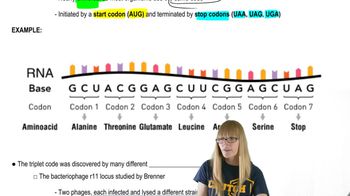Which of the following characteristics does NOT describe the triplet codon code?
Table of contents
- 1. Introduction to Genetics51m
- 2. Mendel's Laws of Inheritance3h 37m
- 3. Extensions to Mendelian Inheritance2h 41m
- 4. Genetic Mapping and Linkage2h 28m
- 5. Genetics of Bacteria and Viruses1h 21m
- 6. Chromosomal Variation1h 48m
- 7. DNA and Chromosome Structure56m
- 8. DNA Replication1h 10m
- 9. Mitosis and Meiosis1h 34m
- 10. Transcription1h 0m
- 11. Translation58m
- 12. Gene Regulation in Prokaryotes1h 19m
- 13. Gene Regulation in Eukaryotes44m
- 14. Genetic Control of Development44m
- 15. Genomes and Genomics1h 50m
- 16. Transposable Elements47m
- 17. Mutation, Repair, and Recombination1h 6m
- 18. Molecular Genetic Tools19m
- 19. Cancer Genetics29m
- 20. Quantitative Genetics1h 26m
- 21. Population Genetics50m
- 22. Evolutionary Genetics29m
11. Translation
The Genetic Code
Problem 1c
Textbook Question
How were the specific sequences of triplet codes determined experimentally?
 Verified step by step guidance
Verified step by step guidance1
Step 1: Understand the concept of the genetic code. The genetic code consists of triplet codons, where each codon is a sequence of three nucleotides in mRNA that corresponds to a specific amino acid or a stop signal during translation.
Step 2: Learn about the experimental methods used to determine the triplet codes. One key method was the use of synthetic RNA molecules in cell-free translation systems. Researchers synthesized RNA sequences with known nucleotide compositions and observed the resulting polypeptides.
Step 3: Explore the work of Marshall Nirenberg and Heinrich Matthaei. They conducted experiments using poly(U) RNA (a sequence of uracil nucleotides) in a cell-free system, which led to the discovery that the codon UUU codes for the amino acid phenylalanine.
Step 4: Investigate the use of mixed RNA sequences. Researchers created RNA molecules with repeating patterns (e.g., poly(UC)) and analyzed the resulting polypeptides to deduce the codons for specific amino acids.
Step 5: Examine the use of triplet binding assays. In this method, researchers used ribosomes, tRNA, and synthetic triplet codons to determine which amino acid-tRNA pairs bind to specific codons, further confirming the genetic code.
 Verified video answer for a similar problem:
Verified video answer for a similar problem:This video solution was recommended by our tutors as helpful for the problem above
Video duration:
1mPlay a video:
Was this helpful?
Key Concepts
Here are the essential concepts you must grasp in order to answer the question correctly.
Genetic Code
The genetic code is a set of rules that defines how the information encoded in DNA is translated into proteins. It consists of triplet codons, each made up of three nucleotides, which correspond to specific amino acids. Understanding the genetic code is essential for deciphering how sequences of DNA dictate the structure and function of proteins.
Recommended video:
Guided course

The Genetic Code
Transcription
Transcription is the process by which the genetic information in DNA is copied into messenger RNA (mRNA). This process involves the enzyme RNA polymerase, which binds to the DNA and synthesizes a complementary RNA strand. Transcription is a critical step in gene expression, as it allows the information in DNA to be translated into functional proteins.
Recommended video:
Guided course

Eukaryotic Transcription
Experimental Determination of Codons
The specific sequences of triplet codes were determined through various experimental methods, including the use of synthetic RNA and ribosomes. Researchers like Marshall Nirenberg and Har Gobind Khorana conducted experiments that involved creating artificial mRNA sequences and observing the resulting protein synthesis, which helped to identify which codons corresponded to which amino acids.
Recommended video:
Guided course

Sex Determination
Related Videos
Related Practice
Multiple Choice
683
views
4
rank


